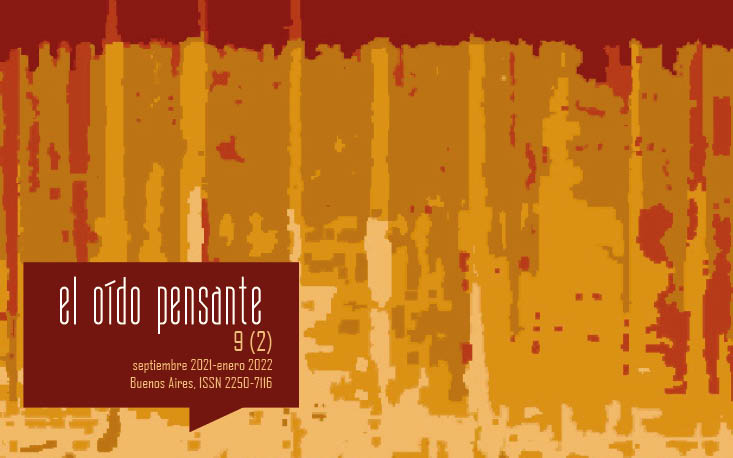El baile en la música del DJ. Interacciones de segunda persona en fiestas de música electrónica
Resumen
Las fiestas de música electrónica son situaciones de performance musical en las que un DJ pasa música para que un público numeroso baile. Esta interacción se presenta como relevante para la práctica musical en diversos estudios, pero sus características particulares aún no han sido indagadas en profundidad. En este trabajo abordamos la perspectiva del DJ a partir del microanálisis de tres entrevistas dirigidas por los autores. Los resultados fueron interpretados desde la Perspectiva de Segunda Persona, que propone la percepción directa de los estados psicológicos en la expresión corporal. Se concluyó que las interacciones DJ-público presentan rasgos propios de la segunda persona: los DJs atribuyen a la entidad unificada público el estar arriba o abajo a partir de la observación gestáltica de la intensidad de sus movimientos de baile, que asumen como consecuencia del nivel de energía de la música. El set musical que el DJ arma durante la fiesta se define por estas atribuciones y se orienta a mantener al público arriba. La importancia de la interacción corporeizada del público con la música pone al baile en el centro de la práctica del DJ, generando una interacción de segunda persona genuina dentro de este contexto social particular.Descargas
Citas
Auslander, P. (2008). Liveness: Performance in a Mediatized Culture, 2nd edition. London: Routledge.
Blázquez, G. (2012). “I Love the Nightlife”: músicas, imágenes y mundos culturales juveniles en Argentina. Trans. Revista Transcultural de Música, 16( 2), 1-26. Recuperado de http://www.sibetrans.com/trans/articulo/406/i-i-love-the-nightlife-i-mu-sicas-ima-genes-y-mundos-culturales-juveniles-en-argentina
Blánquez, J. (2018). Loops 2. Una historia de la música electrónica en el siglo XXI. Barcelona: Reservoir Books.
Blánquez, J. y O. León (Eds.) (2018). Loops 1. Una historia de la música electrónica en el siglo XX. Barcelona: Reservoir Books.
Broughton F. y Brewster B. (2002). How to DJ (Properly). The Art and Science of Playing Records. London: Bantam.
Burger, B., Thompson, M., Luck, G., Saarikallio, S. y Toiviainen, P. (2010). Influence of Musical Features on Characteristics of Music-Induced Movements. Proceedings of ICMPC11. Seattle, USA.
Burger, B. y Toiviainen, P. (2020). Embodiment in Electronic Dance Music: Effects of Musical Content and Structure on Body Movement. Musicae Scientiae, 24(2). doi: https://doi.org/10.1177/1029864918792594
Burland, K. y Pitts, S. (2014). Coughing and Clapping: Investigating Audience Experience. Farnham: Asghate.
Colombetti, G. y Thompson, E. (2008). The Feeling Body: Towards an Enactive Approach to Emotion. En: W. Overton, U. Müller y J. Newman (Eds.), Developmental Perspectives on Embodiment and Consciousness (pp. 45-68). Nueva York: Lawrence Erlbaum Associates.
Corbin, J. y Strauss, A. (1996). Basics of Qualitative Research. Techniques and Procedures for Developing Grounded Theory. (4th Edition). Sage: California.
Gallo, G. M. (2016). Libertades coreografiadas: palabras habladas, comunicaciones corporales y códigos en pistas dance de la ciudad de Buenos Aires. Estudios sociológicos, 34(100), 41-64. doi: 10.24201/ES.2016V34N100.1387
Geeves, A. M., McIlwain, D. J. y Sutton, J. (2016). Seeing Yellow: ‘Connection’ and Routine in Professional Musicians’ Experience of Music Performance. Psychology of Music, 44(2), 183-201. doi: https://doi.org/10.1177/0305735614560841
Glaser, B. y Strauss, A. (1967). The Discovery of Grounded Theory. New Jersey: Aldine Transaction.
Gomila, A. (2002). La perspectiva de la segunda persona de la atribución mental. Azafea, 4, 123-138. doi: https://doi.org/10.14201/3719
Gomila, A. y Pérez, D. (2017). Lo que la segunda persona no es. En D. Pérez y D. Lawler (Comps.), La segunda persona y las emociones (pp. 275-297). Buenos Aires: SADAF.
Gomila, A. y Pérez, D. (2018). Mental Attribution in Interaction: How the Second Person Perspective Dissolves the Problem of Other Minds. Daimon, 75, 75-86. doi: https://doi.org/10.6018/daimon/332611
Laban, R. (1950). El dominio del movimiento. Móstoles: Editorial Fundamentos.
Lakoff, G. y Johnson, M. (1980). Metaphors We Live by. Londres: The University of Chicago Press.
Lakoff, G. y Johnson, M. (1999). Philosophy in the Flesh. Nueva York: Basic Books.
Leman, M. (2016). The Expressive Moment. Massachusetts: The MIT Press.
Marchiano, M. y Martínez, I. C. (2018). Expressive alignment with timbre: changes of sound-kinetic patterns during the break routine of an electronic dance music set. En R. Parncutt y S. Sattmann (Eds.), Proceedings of ICMPC15/ESCOM10. Graz: Universidad de Graz.
Martínez, I. C. (2018). Hacer sentido con el cuerpo en la música. Revista Argentina de Musicología, 19, 43-58. Recuperado de http://ojs.aamusicologia.org.ar/index.php/ram/article/view/264
Martínez, I. C., Español, S. y Pérez, D. (2018). The Interactive Origin and the Aesthetic Modelling of Image-Schemas and Primary Metaphors. Integrative Psychological and Behavioral Science, 52(4), 646-671. doi: https://doi.org/10.1007/s12124-018-9432-z
Meyer-Dinkgräfe, D. (2015). Liveness: Phelan, Auslander, and After. Journal of Dramatic Theory and Criticism, 29(2), 69-79. doi: https://doi.org/10.1353/dtc.2015.0011
Pérez, D. (2013). Sentir, desear, creer. Una aproximación filosófica a los conceptos psicológicos. Prometeo: Buenos Aires.
Pérez, D. y Gomila, A. (2018). La atribución mental y la segunda persona. En T. Balmaceda y K. Pedace (Comps.), Temas de filosofía de la mente (pp. 69-98). SADAF: Buenos Aires.
Pérez, D. y Gomila, A. (2021). Social Cognition and the Second Person in Human Interaction. London: Routledge.
Reynolds, S. (2018). Prólogo. En J. Blánquez y O. León (Eds.), Loops 1. Una historia de la música electrónica en el siglo XX. Barcelona: Reservoir Books.
Schweikard, D. P. y Schmid, H. B. (2013). Collective Intentionality. En E. N. Zalta (ed.) The Stanford Encyclopedia of Philosophy. Recuperado de https://plato.stanford.edu/archives/sum2013/entries/collective-intentionality
Solberg, R. T. y Dibben, N. (2019). Peak Experiences with Electronic Dance Music. Music Perception, 36(4), 371-389. doi: https://doi.org/10.1525/mp.2019.36.4.371
Solberg, R. T. y Jensenius, A. (2019). Group Behaviour and Interpersonal Synchronization to Electronic Dance Music. Musicae Scientiae, 23(1), 111-134. doi: https://doi.org/10.1177/1029864917712345
Stern, D. N. (2010). Forms of Vitality: Exploring Dynamic Experience in Psychology and the Arts. New York: Oxford University Press.
Tanco, M. (2018a). Acerca de lo Narrado en la Performance: Un estudio de la experiencia musical del performer a través de la analogía del Narrador. (tesis de doctorado). Universidad Nacional de La Plata, La Plata, Argentina. Recuperado de http://hdl.handle.net/10915/67834
Tanco, M. G. (2018b). La comunicación performer-público en la performance de la música académica. Revista de Psicología, 17(2), 22-44. doi: https://doi.org/10.24215/2422572Xe020
Toiviainen, P, Luck, G. y Thompson, M. (2010). Embodied Meter: Hierarchical Eigenmodes in Music-Induced Movement. Music Perception, 28(1), 59-70. doi: https://doi.org/10.1525/mp.2010.28.1.59
Turino, T. (2008). Music as Social Life: The Politics of Participation. Chicago: University of Chicago Press
Vasilachis, I. (2006). Estrategias de investigación cualitativa. Gedisa: Spain.























